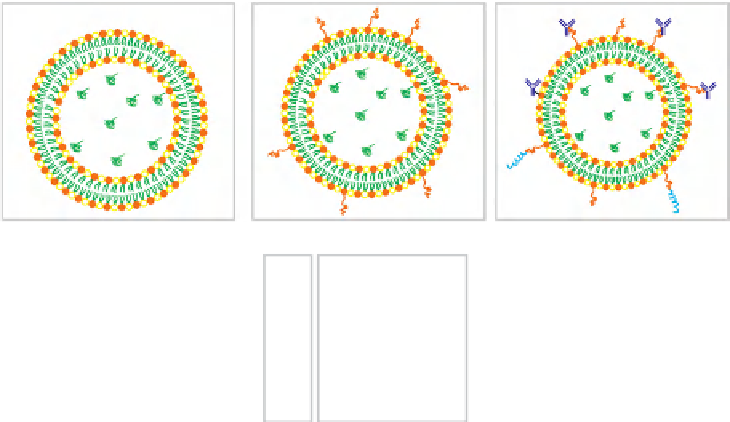Biomedical Engineering Reference
In-Depth Information
(A)
(B)
(C)
Neutral lipid
Cationic lipid
Targeting ligand
PEGlayted lipid
P/P drug
Cell penetrating peptide
Figure 11.7
Schematic diagrams of liposomes along with surface modifications.
(A) Conventional/cationic liposome, (B) stealth liposome, and (C) multifunctional liposome.
11.5.3 Liposomes
Liposomes are biodegradable lipid-based carriers that can be used for controlled drug
release along with targeting of entrapped proteins and peptides; apart from this they
also act as an adjuvant for vaccine delivery, which has been discussed elsewhere in
this chapter
[231,232]
. Advantages of liposomes for proteins and peptides are (1) rela-
tively low toxicity; (2) structural versatility, which allows manipulation of their fate
in
vitro
and
in vivo
; (3) possibility of alterating the physical and chemical characteristics
of the liposomes by changing the lipid composition, thereby optimizing the biological
effect; (4) their aqueous core, which minimizes the risk of irreversible conformational
changes of proteins induced by dehydration
[233,234]
; (5) their ability to act as cir-
culating drug reservoirs for prolonged release, while providing protection and reduc-
ing immunogenicity and other adverse side effects. P/P (e.g., INF-) targeting with
liposomes, hybrid liposomes like silica nanoparticle-coated liposomes for insulin
delivery, and some more recent advancements in the field of liposomes have remark-
ably facilitated P/P drug delivery along with stability on storage as a lyophilized form
[231,232,235-238]
.
Figure 11.7
shows a diagrammatic representation of liposomes
along with surface modifications to improve the delivery of P/P drugs.
If administered by an intravenous route, liposomes are generally taken up by the
reticuloendothelial system (RES) because of their particulate nature. The use of special-
ized phospholipids, esterified with hydrophilic groups such as polyethylene derivatives
(
Fig. 11.7
) and ganglioside GM
1
, has been investigated as a means to avoid RES elim-
ination and thus prolong the
in vivo
circulation time. These liposomes are known as
sterically stabilized liposomes or stealth liposomes
[237]
. Liposomes containing nega-
tively charged lipids that are not sterically shielded (phosphatidylserine, phosphatidic


Search WWH ::

Custom Search